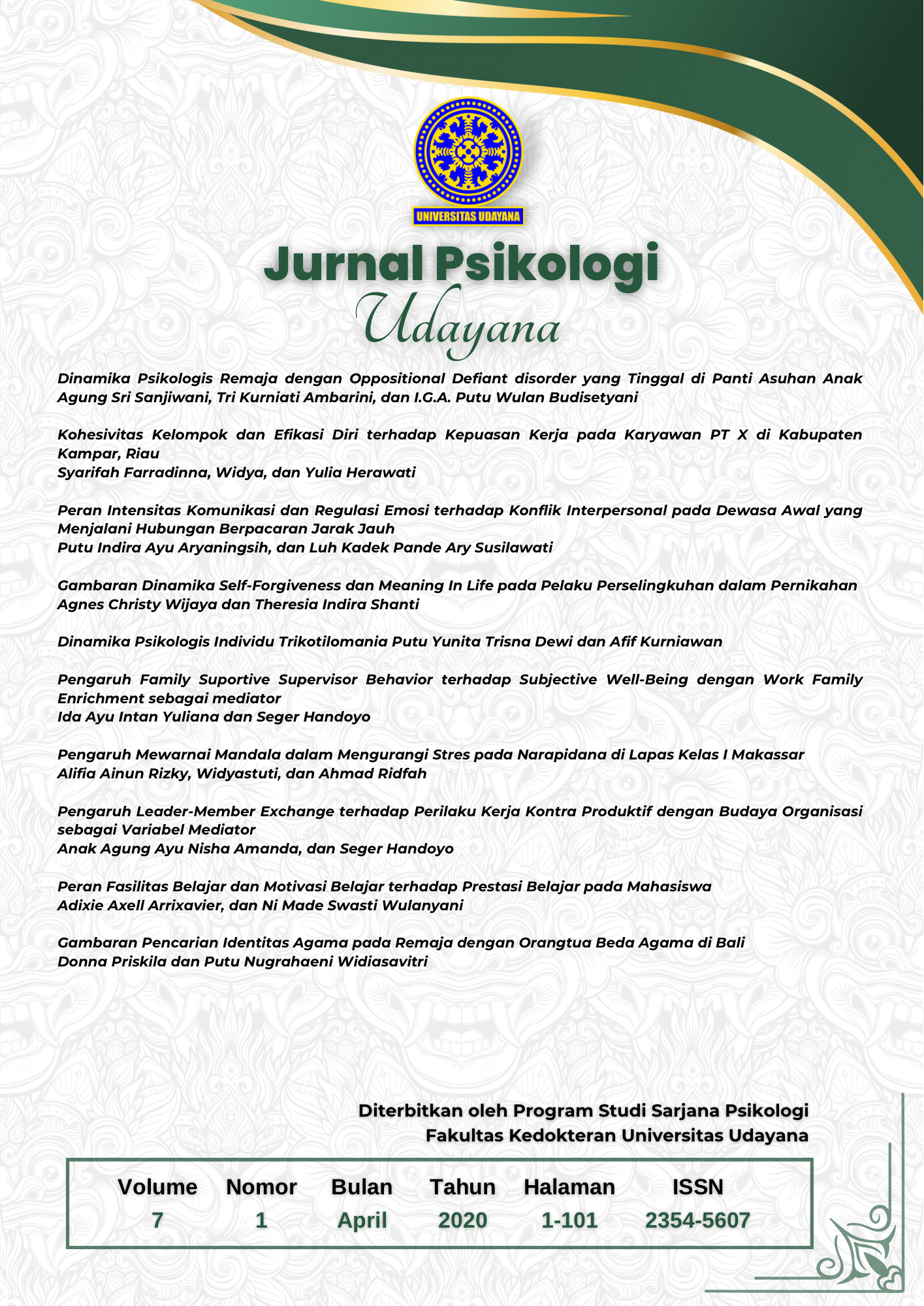Dinamika psikologis individu yang mengalami trikotilomania
Abstract
Trikotilomania merupakan gangguan perilaku menarik rambut secara berulang yang bersifat kronis dan mengakibatkan terjadinya kerontokan rambut. Pada individu dewasa, Trikotilomania lebih banyak terjadi pada wanita dibandingkan pria. Penelitian ini bertujuan untuk mengetahui lebih lanjut hasil asesmen, diagnosis, serta dinamika psikologis yang mendasari munculnya gangguan perilaku menarik rambut pada subjek NR selama kurang lebih 10 tahun. Subjek dalam penilitian ini berjumlah satu orang dan berjenis kelamin perempuan. Penelitian ini menggunakan metode kualitatif dengan teknik studi kasus. Teknik pengambilan data atau kegiatan asesmen dalam penelitian ini terdiri dari wawancara semi terstruktur, observasi, tes grafis (BAUM, DAP, dan HTP), Sack’s Sentence Completion Test (SSCT), tes inteligensi menggunakan Weschler Adult Intelegence Scale (WAIS), serta Thematic Apperception Test (TAT). Berdasarkan pada rangkaian hasil asesmen psikologi yang telah dilakukan, subjek NR terdiagnosa mengalami Trikotilomania. Perilaku menarik rambut merupakan refleksi dari kecemasan NR terhadap berbagai hal yang sulit ia ekspresikan. Kecemasan tersebut berawal dari kondisi self esteem NR yang cenderung rendah, sehingga perilaku menarik rambut menjadi sebuah kebiasaan yang dapat muncul tidak hanya pada situasi yang menekan dan sulit untuk dihentikan. Akibat perilaku menarik rambut tersebut, subjek NR mengalami kerontokan rambut dan iritasi pada area kulit rambut.
Downloads
References
American Psychiatric Association., & American Psychiatric Association. (2000). Diagnostic and statistical manual of mental disorders: DSM-IV-TR. Washington, DC: American Psychiatric Association.
Atwater, E. (1983). Psychological of Adjustment. Second Edition. New Jersey: Prentice Hall. Inc
Casati, J., Toner, B. B., & Yu, B. (2000). Psychosocial issues for women with trichotillomania. Comprehensive Psychiatry, 41(5), 344–351. https://doi.org/10.1053/comp.2000.9012
Christenson, A., Mitchell, J. E., & Mackenzie, B. (1991). Gary A. Christenson,. The American Journal of Psychiatry, 148(March), 365–370.
Demetriou, S. (2019). Emotion regulation in disorder ): The role of stress and trauma by.
Diefenbach, G. J., Mouton-Odum, S., & Stanley, M. A. (2002). Affective correlates of trichotillomania. Behaviour Research and Therapy, 40(11), 1305–1315. https://doi.org/10.1016/S0005-7967(02)00006-2
Diefenbach, Gretchen J., Tolin, D. F., Hannan, S., Crocetto, J., & Worhunsky, P. (2005). Trichotillomania: Impact on psychosocial functioning and quality of life. Behaviour Research and Therapy, 43(7), 869–884. https://doi.org/10.1016/j.brat.2004.06.010
Diefenbach, Gretchen J., Tolin, D. F., Meunier, S., & Worhunsky, P. (2008). Emotion regulation and trichotillomania: A comparison of clinical and nonclinical hair pulling. Journal of Behavior Therapy and Experimental Psychiatry, 39(1), 32–41. https://doi.org/10.1016/j.jbtep.2006.09.002
Flessner, C. A., Conelea, C. A., Woods, D. W., Franklin, M. E., Keuthen, N. J., & Cashin, S. E. (2008). Styles of pulling in trichotillomania: Exploring differences in symptom severity, phenomenology, and functional impact. Behaviour Research and Therapy, 46(3), 345–357. https://doi.org/10.1016/j.brat.2007.12.009
Grzesiak, M., Reichp, A., Szepietowsk, J.C., Hadrys, T., & Pacan, P. (2017). Trichotillomania among young adults: Prevalence and comorbidity. Acta Derm Venereol. 97. 509-512.
Grant, J. E., Chamberlain, S. R., & Ph, D. (2016). Trichotillomania. The American Journal of Psychiatry, 173(9), 868–874.
Grant, J. E., Dougherty, D. D., & Chamberlain, S. R. (2020). Prevalence, Gender Correlates, and Co-morbidity of Trichotillomania. Psychiatry Research, 288(March), 112948. https://doi.org/10.1016/j.psychres.2020.112948
Kail, R.V & Cavanaugh, J.C. (2010). Human development: A Life-span view. Fifth Edition. USA: Wadsworth Cengage Learning
Kell, B. L., & Kress, V. E. (2006). Trichotillomania: Behavioral assessment and treatment interventions. International Journal of Behavioral Consultation and Therapy, 2(1), 65–72. https://doi.org/10.1037/h0100767
Morris, S. H., Zickgraf, H. F., Dingfelder, H. E., & Franklin, M. E. (2013). Habit reversal training in trichotillomania: guide for the clinician. Expert Review of Neurotherapeutics, 13(9), 1069–1077.
Schreiber, L. R. N., Odlaug, B. L., & Grant, J. E. (2011). Diagnosis and treatment of trichotillomania. Neuropsychiatry, 1(2), 123–132. https://doi.org/10.2217/npy.11.8
Walther, M. R., Ricketts, E. J., Conelea, C. A., & Woods, D. W. (2010). Recent advances in the understanding and treatment of trichotillomania. Journal of Cognitive Psychotherapy, 24(1), 46–64. https://doi.org/10.1891/0889-8391.24.1.46
Weiten, W., Dunn. D.S., & Hammer, E.Y. (2012). Psychology Applied to Modern Life: Adjustment in the 21st Century. Tenth Edition. USA: Wadsworth, Cengage Learning
Woods, D. W., & Houghton, D. C. (2014). Diagnosis, evaluation, and management of trichotillomania. Psychiatric Clinics of North America, 37(3), 301–317. https://doi.org/10.1016/j.psc.2014.05.005

This work is licensed under a Creative Commons Attribution-ShareAlike 4.0 International License.
Authors who publish with this journal agree to the following terms:
- Authors retain copyright and grant the journal right of first publication with the work simultaneously licensed under a Creative Commons Attribution-ShareAlike 4.0 International License that allows others to share the work with an acknowledgement of the works authorship and initial publication in this journal.
- Authors are able to enter into separate, additional contractual arrangements for the non-exclusive distribution of the journals published version of the work (e.g., post it to an institutional repository or publish it in a book), with an acknowledgement of its initial publication in this journal.
- Authors are permitted and encouraged to post their work online (e.g., in institutional repositories or on their website) prior to and during the submission process, as it can lead to productive exchanges, as well as earlier and greater citation of published work (See The Effect of Open Access).













